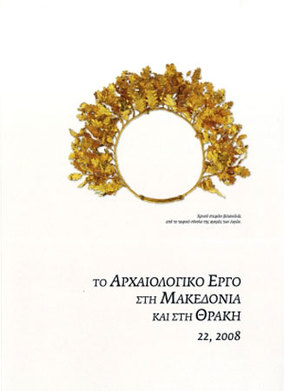Τούμπα Θεσσαλονίκης 2002 : το αρχαίο νεκροταφείο στην "Αλάνα"
Part of : Το Αρχαιολογικό Έργο στη Μακεδονία και στη Θράκη ; Vol.16, No.1, 2002, pages 277-289
Issue:
Pages:
277-289
Parallel Title:
Toumba Thessaloniki prefecture 2002 : the ancient cemetery of “Alana”
Author:
Abstract:
I Alan aIn May 2002, after test sections had located graves, the archaeological excavation began of the site which is intended for an underground car park NW of the PAOK football stadium and next to (E. of) the IKA clinic in Toumba, and which is known as the Toumba alana (“waste ground”). For a number of years this was the site of the 3rd military-vehicle park, where excavations were carried out before the War.The total area of the site investigated is 3,500 m2 and a total of 56 graves were located, scattered mainly in the E. and N. parts; in the W. were uncovered building remains of the 4th century BC and some pits containing abundant hand-made pottery of the Iron Age. An Iron Age settlement may well have pre-existed in this area and been demolished and, in the 4th century BC, replaced by habitations connected with the cemetery, accommodation for people directly connected with the site of the cemetery or with a guard site.As regards the cemetery, the 56 graves seem to cover a wide span of time, from the 6th to the late 4th or early 3rd century BC. Irrespective of when the graves were made, one specific type was consistently observed, namely a pit-grave with a slate covering. The child’s cist-grave was an isolated exception.Four graves stand out as being rectangular in shape with clay walls and no cover and containing cremation burials dating to the 4th century BC.The grave goods were mainly vessels, produced by Attic, Corinthian, and local Macedonian workshops; also gold, silver, and bronze jewellery, zoomorphic clay figurines, and clay female busts.II. Triandria: building plot at 27, Amorgou StreetDuring the excavation of the building plot at 27, Amorgou St. in Triandria, the presence of at least 2 archaeological phases was noted. The first phase, dating to the Late Roman period, is represented by a fragmentarily preserved conduit, of which only the bottom survives, lined with hydraulic plaster. The pit located to the W. of the conduit and the extensive cairn at the W. end of the plot must also belong to this phase.The second archaeological phase relates to the use of the site as a cemetery in the 6th, 5th, and 4th centuries BC. A total of 10 graves were located, 7 of them being pit- graves with slate covers and 2 sarcophagi of yellowish poros.The grave goods were noteworthy, with (Ionic, Corinthian, Attic, and local Macedonian) vessels predominating, but also with gold mouth-pieces, gold strips, and silver and bronze jewellery.
Subject:
Subject (LC):
Keywords:
νεκροταφεία, Θεσσαλονίκη
Notes:
Περιέχει εικόνες και κατόψεις




